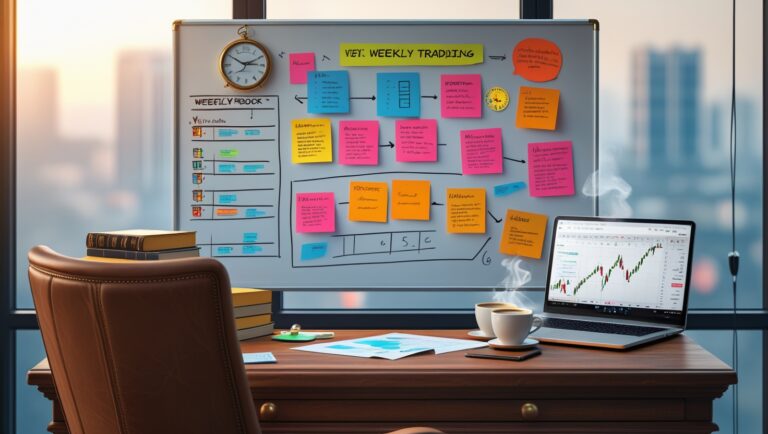What Most People Get Wrong About Stock Trading With a Day Job
What Most People Get Wrong About Stock Trading With a Day Job
Most people think trading stocks with a full-time job is impossible. I used to think the same. I thought I had to be glued to the screen all day, chasing every alert and trying to catch every move while answering emails and attending Zoom calls. But that mindset was holding me back.
Trading with a day job isn’t about doing more — it’s about doing less, better.
When I started trading, I wasted time trying to follow full-time traders. I’d jump into trades mid-shift, miss good entries because I was distracted, and exit too early out of panic. What I didn’t realize was that my strength wasn’t in being available all day — it was in creating a system that worked around my actual schedule.

Table of Contents
How I Made It Work With My Job
I built a system that worked for me — not someone else. I started by focusing only on the first 30 minutes of the market. That’s when momentum is the highest, and that’s when I could actually focus before starting work.
I created a daily routine where I prep my watchlist before 9:30AM and only focus on a handful of stocks — usually no more than 6. That alone removed 90% of the stress.
And no, I didn’t learn this from an expensive course. I figured it out on my own through trial and error — and that’s exactly what I break down in my ebook. It’s the full system I use today to spot stocks before they move — without being tied to my screen.
The Myth of “Trading All Day”
Most new traders think that to succeed, they need to be active from open to close. But that’s not true. I trade 2–3 times a week, in short windows, and that’s it. The key is waiting for clean, high-probability setups — not forcing trades because you feel like you should be doing something.
What Really Matters When You Have a Job
When your time is limited, you have to be intentional. You don’t have time to gamble. That’s why I built a repeatable plan:
- I prep before the market opens
- I track stocks with volume and news
- I wait for setups that make sense to me
- I stick to my rules
This plan doesn’t require indicators. It doesn’t require expensive software. It just takes focus and repetition — which is exactly what I teach in my ebook.
Why I Wrote My Ebook
I get a lot of questions about how I manage to pay my bills by trading while still keeping a life outside of charts. That’s why I created the ebook — to show exactly how I do it. Not theory. Not hype. Just the real system that pays my bills every month.
If you’re tired of chasing trades and wasting time, and you want a strategy that respects your work schedule — this was made for you.
➡️ Grab it here: https://stockflowreport.gumroad.com/l/paybillswithstocks
What Most People Get Wrong About Stock Trading With a Day Job
Most people overlook the power of pre-market planning. I used to wake up right before the bell, scramble to check Twitter or Discord for alerts, and trade blindly. But once I built a habit of planning before 9AM, everything changed. I stopped following noise and started following my own system.
Discipline is more powerful than speed. New traders often feel pressure to act fast, like they’ll miss out. But when you’re trading with a job, you can’t afford to be reactive. I learned how to slow down, plan my entries, and only pull the trigger on high-probability setups. That’s when my account started to grow.
I also created watchlists the night before or early in the morning, based on what’s gapping up, what’s trending, and where the volume is going. This helps me avoid wasting time during the day. If the setup doesn’t match, I skip the trade. Simple.
One of the most powerful shifts I made was letting go of indicators. I used to fill my charts with RSI, MACD, VWAP — you name it. But I realized that all I needed was price action, volume, and clean structure. That’s what my entire strategy is based on now, and that’s what I explain inside my ebook.
Another mistake I used to make was thinking more trades meant more money. But what I found is that trading less actually made me more profitable. Now, I only take setups that feel obvious to me. I don’t touch a stock just because it’s moving — I trade it because it fits my setup and my timing window.
My job forced me to create a low-stress, consistent trading style, and honestly, that’s a blessing. I’m no longer fighting FOMO, I’m not stuck on my screen, and I’m not stressing over trades during meetings. That kind of clarity only comes from having a plan and sticking to it.
If you’re someone who works a 9–5 but still wants to trade, you have to protect your energy. The best way to do that is to trade before work or right at the open, then be done. Let the pros sit in front of their screens all day — you don’t need to.
And you don’t need to trade every day either. I trade 2 or 3 times a week, and my setups are clean because I wait. My whole focus is paying bills with stocks, not trying to get rich overnight. The more patient I became, the more consistent my results were.
In my ebook, I walk you through exactly how I spot these trades, how I build my watchlist, and how I know when to stay out. If you’re tired of overcomplicating trading, this is the path I wish I had taken from day one.
Another thing I learned the hard way: don’t rely on alerts from other people. By the time you get the alert, the move is already gone or too late. I stopped that habit years ago. I explain how to build independence and trade with confidence in my ebook.
If I can grow an account and pay my rent while working a regular job, so can you. It just takes the right mindset, the right approach, and a simple but effective system. You don’t need a mentor. You don’t need 10 courses. You just need to start.
➡️ Want my step-by-step plan? Download the ebook now:
https://stockflowreport.gumroad.com/l/paybillswithstocks

Stay ahead in the stock market! Subscribe to our newsletter and receive exclusive stock flow reports, trading insights, and actionable tips directly in your inbox. Join thousands of traders who get our updates first.







